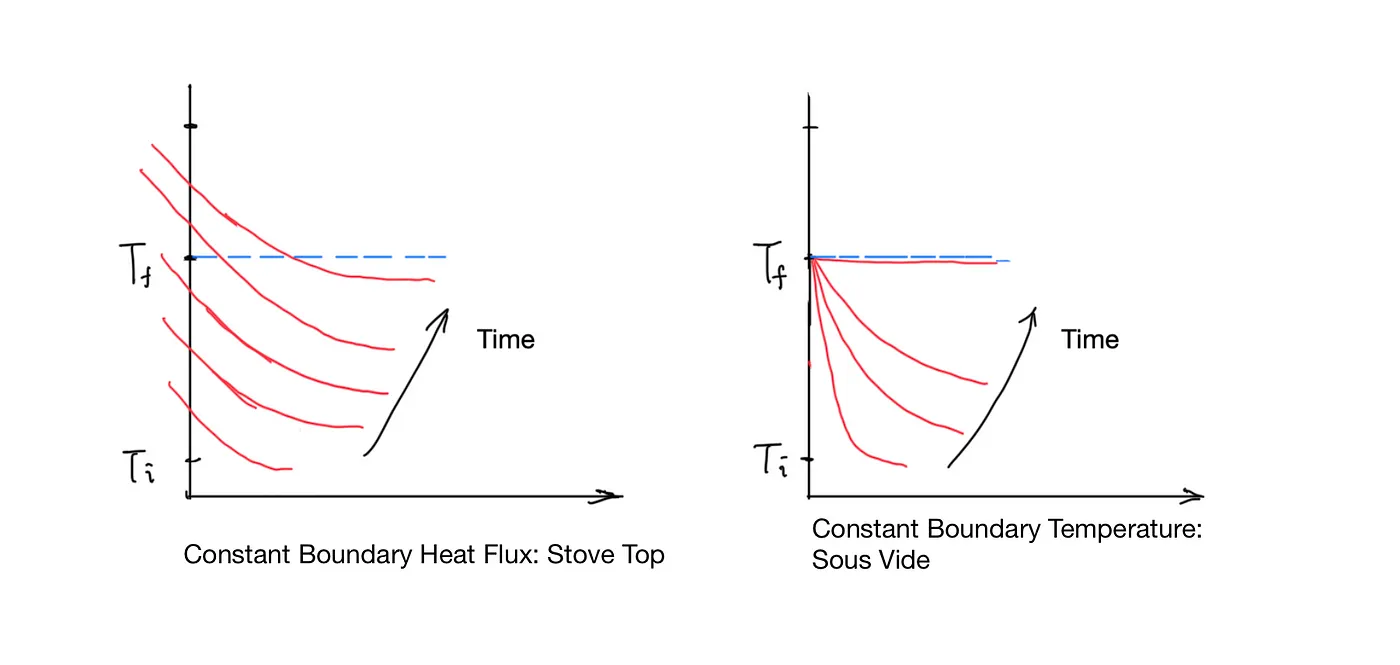Cooking the Egg
On the outer surface of the eggshell, heat transfers by convection. On the other side of the eggshell, i.e., inside the egg, the heat mostly transfers by conduction. It’s something the cook cannot get around, no matter what is being cooked: you can try to control how heat gets to the surface of the food, but once it gets there, you lose control. Inside, the material and composition of the food completely determine the nature of heat transfer. The best you could hope for is good data about the temperature gradient inside.
Conventionally, there are three ways to control the heat distribution inside the food. The first is to control the heat input to the food by controlling the duration and intensity of the burner’s heat output. The cook can turn the knob on the burner and decide when to turn it off completely. There are different oven and stove technologies, but at the end of the day, most home cooks only have rough control of the output power and timing. Clearly, multiple conditions for the equations that govern heat transfer are not under control, and what can be controlled is not controlled with precision.
The second way is to cut food up. Chefs often emphasize that you need to cut food into equal sizes. The idea is if they are the same size, they will be cooked to the same extent. Stir fry recipes often call for thinly sliced food. In stir fry, ingredients touch the hot surface only briefly. To make sure everything is cooked through, it’s important to increase the ratio of surface area to volume. With less depth for the heat to penetrate, it’s easier for the chef to judge the temperature inside the food by looking at the surface. I suspect that’s why expensive Wagyu beef always seems to be cut into small pieces when grilled (but then I realized, a more compelling reason may be: if you are paying so much for it, you shouldn’t have to cut your own food).
Both of those methods are imprecise and highly dependent on the skills and experience of the cook. The fundamental problem is a mismatch of the input (heat) and the desired outcome (temperature).

The two different boundary conditions
The figure above shows the temperature distribution inside food under different boundary conditions. is the initial temperature throughout the food. is the desired final temperature. A typical stove can be modeled as a heat source providing constant heat flux. A constant heat flux means a constant temperature gradient. Over time, the surface temperature of the food rises, and an undesirable temperature gradient inside the food develops. As you can see from the left side of the figure, part of the food is overcooked and part of the food is undercooked. The only way to eliminate the undercooked portion is to turn off the heat just in time and let the residual heat finish cooking. Without quantitative data on the curve of temperature vs. depth and how it changes over time, the chef can only rely on experience. There is only a very small window to get it right, and part of the food is inevitably overcooked.
However, if we change the boundary condition and keep the surface temperature constant, eventually all of the food will achieve thermal equilibrium at exactly the right temperature. You don’t need to worry about how the temperature gradient inside the food is, and you don’t need to worry about carry-over cooking, because there is none.
The technique to achieve this is sous vide cooking. In essence, it’s cooking food in a constant temperature water bath. Not only does it make it possible to achieve uniform temperature inside food, it also gives you much more precise control of the temperature. If you have always poached salmon in stock, you will never know the difference a couple of degrees (from 49⁰C to 51⁰C) makes. Sous vide also creates very pure tastes. Carrots cooked sous vide taste different from roasted carrots because they don’t have the flavor developed by the Maillard reactions under high temperature.
Sous vide cooking is a vast topic that deserves its own dedicated article. I will close this discussion of sous vide by saying that, though it’s not the solution to all your cooking problems, due to its unique advantage from the perspective of heat transfer, it should be an important tool in any chef’s toolbox.
As mentioned earlier, if we want the egg yolk to be runny and safe to eat, we need to make sure it reaches around 63⁰C for 5 minutes. The only way to ensure that is to cook the egg in a 63⁰C water bath for a sufficiently long time. As mentioned above, this temperature does not set the white. We still need to heat the white to a higher temperature. In Modernist Cuisine, the suggestion is to dip the egg in boiling water after sous vide.
As a practical matter, eggs should be started in a room temperature water bath. The water bath is then heated to the desired temperature. The gradual heating process lets the air in the air pocket inside the egg slowly leak out. Otherwise, the air pocket might expand too fast and crack the eggshell.
We have one last problem: peeling the eggshells. The most useful advice I can give you is: stop looking for a magical way to peel the eggshells cleanly. There is none. The only kind of eggs with easy-to-peel shells are overcooked eggs and old eggs. My solution, especially for perfectly cooked soft-boiled eggs with delicate whites and runny yolks, is not to peel them at all. Instead, use an egg topper. It takes some practice, but anyone can master it.

Egg toppers—you don't have to peel the eggshell